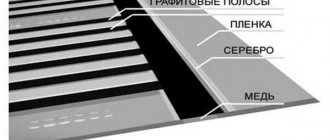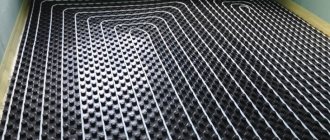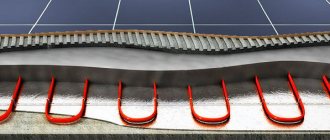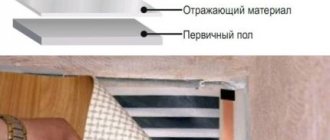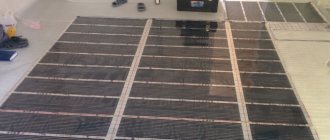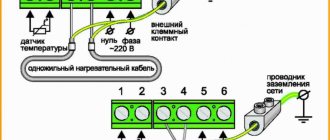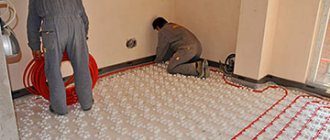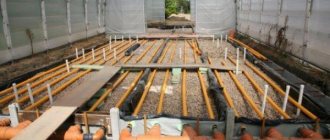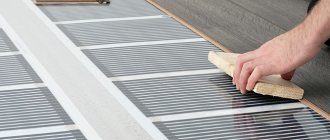No. 1. Film heated floor design
Film heated floors produce infrared radiation and heat not the air, like other underfloor heating systems, but the surrounding objects. The heat obtained in this way can be compared with solar heat, which is why it is called the most harmless and even beneficial for human health. Infrared rays are emitted by 16 mm wide carbon strips, and electrical energy is supplied to them via silver-plated copper bars, which produces heating. The film is laminated on both sides with a polymer, which protects the elements of the heating structure from moisture and mechanical influences and prevents possible fires.
Due to the design features and dense arrangement of heating elements, heating is carried out much more evenly than when using a water or conventional electric heated floor. Moreover, since the film consists of separate elements independent of each other, the failure of one of the parts will not entail a breakdown of the entire system - it will be enough to replace the damaged area, and even before its replacement, the rest of the film will continue to emit heat.
In addition to the film panels themselves, the infrared heated floor system also includes temperature sensors and a thermostat . The purpose of these elements is clear from the name: sensors record the floor temperature, and regulators, which come in a variety of modifications, allow you to monitor sensor readings and adjust the degree of their heating. The thermostat is installed on the wall, close to a switch or outlet, to make it easier to supply power. If the power of the heated floor is above 2 kW, then it will be necessary to connect the system through a separate circuit breaker.
Carbon elements boast an efficiency of 98%, they effectively convert electrical energy into heat.
When organizing normal thermal insulation, electricity consumption will be at the level of 35-50 W/m2*h.
Overview analysis of popular models
The increasing demand for infrared heated floors is objectively influenced by the fact that many well-known companies are involved in its production.
Warm floor Kaleo, its structure
Among the assortment of high-quality models, the products of NPK Monocrystal are noted. The manufacturer offers not only heated floors, but also film baseboards, contours in the openings of windows and doors.
You can purchase an inexpensive film heated floor offered by the Russian one. The production process uses high-quality components from leading global manufacturers from Germany, Korea, and America.
Infrared floors from various Korean companies have become famous. You can have products whose products are oriented for different types of finishing coating. Terma models with a high degree of protection against electrical shock are in demand.
What are the types of electric heated floors?
Another popular Korean brand, NanoThermal, offers film floors with high resistance to aggressive substances and high temperatures. The latest developments of “Heat Plus” in this promising direction do not leave consumers indifferent. Consumers also note Enerpia infrared floors, which can easily provide heating for any living space.
No. 2. Pros and cons of warm film floors
The design features of film heated floors allow us to talk about a lot of its advantages :
- simplicity and high speed of installation , no need to install a cement screed, which allows you to install a heated floor in the shortest possible time even after all repair work has been completed;
- manufacturers say that dismantling the film is as easy as installing it, so you can literally take it with you when you move;
- the minimum thickness of the film and the absence of screed allows you to maintain the height of the room;
- the floor heats up almost instantly;
- uniform heating of the floor and room surfaces;
- possibility of using any decorative floor covering, incl. linoleum and laminate. Difficulties arise only when laying tiles, but more on that later;
- versatility _ The film can be mounted not only on the floor, but also on walls and ceilings. Moreover, the features of the material allow it to be used in rooms with heavy loads on the floor covering, incl. in gyms, shopping centers, offices. The film can be used to heat garages, greenhouses, sheds, and can also be used to prevent porch icing;
- declared by the manufacturer, under the operating conditions specified by him, harmlessness (and even usefulness) for the health of all inhabitants of the house.
disadvantages :
- this is still a fairly expensive system;
- susceptible to mechanical damage, so you should be especially careful during installation;
- Improper installation and operation may result in the film catching fire .
Heating elements should not be placed in places where large furniture will be permanently placed. This recommendation applies to absolutely all underfloor heating systems, but in the case of infrared film we can deal with the failure of an entire fragment as a result of overheating due to insufficient heat transfer.
The film is heated to a temperature of 330C, which allows it to be used together with such a “delicate” coating as linoleum, but this imposes restrictions on use as the
main source of heat : in this case, the film must cover at least 70% of the floor area. Comfortable temperatures can only be achieved in regions with mild winters - otherwise, such a warm floor can be used as an auxiliary heat source , providing comfortable movement barefoot on the floor and allowing you to warm up the room in the autumn-spring period, when central heating is or is not yet working .
Installation features
Before you start installing an infrared floor, you need to check the condition of the electrical wiring so that problems do not arise in the future.
After fixing the substrate, the film is spread in accordance with a pre-developed pattern. The segments are connected to each other. The thermostat is connected and a temperature sensor is installed. After checking the full functionality of the film floor, an additional layer of thermal insulation is laid, if required according to the manufacturer's instructions. All that remains is to fix the finishing coating.
Two connection diagrams for film heated floors
When choosing an infrared heated floor, you need to carefully study all its possibilities. This stage takes on particular importance if it is decided to use it as the main heating structure. Given the affordable cost of the entire set of film flooring, further use in large areas may be too expensive. The most economical option remains the use of infrared heating as an additional option or in conditions of non-permanent residence.
No. 3. Types of infrared film floor
Based on the type of carbon coating applied, modern film floors are divided into two types:
- those on which the coating is applied in strips ;
- those that have a continuous coating .
The first ones are most widespread and perform well in operation, but films with a continuous layer of carbon are more advanced. In striped films, individual strips are connected into groups, and cuts can be made between these groups. Since the strips are connected in parallel, if one of the parts is damaged, the rest continue to work. Inconvenience may arise if the damage area is large enough.
A film with a continuous carbon coating is also divided into separate blocks, but if a separate area is damaged, the heating temperature will be lower only near a cut or hole - in other areas the indicators will remain unchanged, and this is a big plus . Moreover, since the carbon coating is continuous, heating is carried out even more evenly than when using striped film, because there are no so-called. dead zones. The service life of such film is about 50 years , but the price is several times higher. Tests and comparisons in the video below.
No. 4. Safety of film heated floors (fire)
Photo from the site https://homemasters.ru/forums/topic/30943-opyt-ispolzovaniya-teplogo-pola-caleo/. Discussion of the problem of fire of film heated floors
No matter how much manufacturers praise their products and declare their safety, consumer reviews from time to time appear online containing photos of heated film floors that have caught fire. And we are not talking about a fire in the wiring, but about a fire in the heating mat itself.
The manufacturer, represented by a consumer technical support specialist, often refers to non-compliance with the installation rules specified in the technical documentation for the product. Often mentioned:
- Incorrect installation of temperature sensor;
- Insufficient heat transfer . The gap between the floor and the object too (for example, furniture without legs, a carpet was laid, a rag was forgotten on the floor, or a pet simply fell asleep in a warm place). Significant restrictions are imposed on the subsequent rearrangement of furniture, the use of carpets and other coverings, etc. ;
- lack of grounding . In many Soviet-built apartment buildings, there is no grounding from the moment the building was designed. Accordingly, it seems impossible to fulfill the requirements for grounding heated floors and all responsibility falls on the consumer.
- There are also recommendations for installing reliable thermostats . But the concept of “ reliability ” is not applicable to fire safety. You should only trust the term “ 100% safe ,” which you probably won’t find on the packaging or in the accompanying documentation for the product.
- Mandatory installation of automatic de-energization when the load in the heated floor circuit increases. Only a specialist can make the correct calculation of such a system; however, this system will only reduce the risk, albeit significantly, of electric shock or fire.
What conclusion can be drawn from this?
- Installing and operating film heated floors is not at all a safe undertaking, and in the vast majority of cases, the responsibility will fall on the consumer .
- Installation and operation of electric heated floors in rooms with high humidity increases the likelihood of a dangerous situation for the health and life of a living being. If you pay attention to some of the technical improvements actively advertised by manufacturers, it is not difficult to notice the appearance of new elements in the design of electric underfloor heating systems, for example anti-spark mesh . This indicates that the manufacturer has improved the safety of its products. But on the other hand, the manufacturer somehow did not pay attention to this and there is no guarantee that the approach to informing the consumer will change.
- The material floor covering must be 100% non-flammable , be dielectric , be sealed , and have sufficient thermal conductivity under real operating conditions (tea, water, a bottle of solvent or nail polish remover have been spilled). Those. coatings such as laminate, cork, wood, linoleum already make us think about their use with a system of electric heated floors. Ceramic tiles, porcelain tiles and similar materials look most advantageous
- Installation of electric heated floors must be carried out in strict compliance with the documentation supplied by the manufacturer of the specific product. At the same time, read the documentation before purchasing to ensure that your capabilities (for example, grounding) match the manufacturer’s requirements . All this requires time, knowledge and experience, therefore, it is wiser to entrust it to a specialist.
- It is probably worth choosing a specialist of responsibility assumed , regarding in the event of any problems arising related to the functioning and safety of the underfloor heating system.
- From a safety point of view, it is better to pay attention to models with 12V power supply . The lower the voltage, the safer it is for humans. “However, in the presence of dampness, the resistance of the human body decreases sharply and voltage only below 12 V can be considered safe.”
No. 5. What to look for when choosing?
When purchasing film infrared heated floors, it is important to pay attention to the name of the manufacturer, the stated characteristics and appearance of the film. What should a high-quality film look like and what performance qualities should it have? When choosing, pay attention to the following parameters:
- power , which directly determines what kind of floor covering the film can be used with. The power consumption of the system ranges from 130-450 W/m2. For installation under linoleum, carpet and other light floor coverings, a film with a power of up to 160 W/m2 will be sufficient; for tiles and porcelain stoneware it is better to take a more powerful film - up to 220 W/m2, and everything that is more intended for use in industrial conditions and infrared saunas;
- The thickness of the film depends on the thickness of the polymer and carbon layers; it ranges from several microns to several millimeters. The minimum permissible thickness is 0.3 mm; the generally accepted thickness is 0.338 mm. The greater the thickness, the more durable the protective shell will be and resistant to deformation. Some manufacturers insist that the film should be as thin as possible so as not to take away the height of the room, but the difference in height when installing a film of 0.3 and 3 mm will be imperceptible, and the durability of the latter will be many times higher;
- film width. The material is produced in rolls with a width of 50, 60, 80 and 100 cm. During installation, the film is mounted so that adjacent sections are as close as possible to each other, but do not overlap one another. Based on this rule and the parameters of the room, the most suitable roll width is selected to ensure the fastest possible installation and minimize waste;
- strips made of silver and copper alloys must have clear contours, not show through, and be free from damage and signs of oxidation. The higher the silver content, the more durable and less sparkling the film will be. The silver part can be 1.5-2 mm wider than the copper part;
- preference should be given to those films where the copper and silver busbars are connected by a “dry” contact, which allows minimizing the thickness of the air gap and extending the service life of the product;
- The width of the copper bus must be at least 13-15 mm, otherwise we can talk about the low quality of the film. Carbon strips will not be visible or felt through copper;
- The carbon layer must be applied evenly and not show through. The thicker its layer, the longer the film will last;
- some manufacturers add silver in carbon pasteto minimize its current resistance and improve contact with the bus. Over time, a cold tire Maybe peel off from the constantly heated carbon part, and the result may be sparking and reduction in heating power. Large companies that are constantly improving their products are coming up with different ways to avoid sparks. Most efficient development — arrangement of a grid of silver strips at the border of the carbon coating and the copper busbar. This configuration is called anti-spark mesh;
- the spaces between the carbon strips can be transparent or cloudy - the difference is in the manufacturing features. The first option is obtained by using adhesive technology, the second by lamination . After a few months of use, adhesive strips become brittle, but laminated strips last for years , so give preference to them;
- The heating speed of high-quality infrared film is 5-10 seconds.
No. 6. Large manufacturers of infrared film flooring
The quality and compliance of the actual technical properties with those indicated on the packaging depends on the name of the manufacturer. Today, there are more and more different companies producing warm film floors, but many of them, unfortunately, do not offer the most durable products. When purchasing, pay attention to products from reputable manufacturers:
- Caleo is the largest company in the industry, it owns numerous innovations and developments. The manufacturer from South Korea has been producing warm film floors since 2006, and since then has become a real leader in the field.
It is this company that develops floors with anti-spark mesh. Today, the range includes several modifications of heated floors: from budget to luxury options. The quality is top notch in any case, the warranty is from 7 to 15 years, there are also thermostats, cable heated floors and heating systems for roofs, pipes and drains on sale; - Heat Plus is another Korean company that, over several years of activity in Russia, has been able to make the brand recognizable and establish sales and service in many large cities. The company produces striped and solid infrared film with power from 80 to 450 W;
- TEPLOTEX is a Korean company that produces only striped film, minimum thickness 0.37 mm.
If installed correctly, the film can be used for 30 years. Roll width from 50 to 100 cm; - Rexva is a large Korean manufacturer with a market share of about 60%. The domestic buyer became acquainted with the brand’s products not so long ago, but has already managed to appreciate their highest quality. The company is also one of the leaders in terms of innovation. Due to double-sided lamination with electrical polyester, complete moisture resistance is ensured. In addition, the products can withstand high temperatures, are difficult to ignite, and do not emit acrid smoke. The film width is 50, 80 and 100 cm, thickness 0.338 mm;
- Eastec is a company from the same South Korea, where the technology of infrared heated floors was invented and where most of such products are produced today. The company offers films with a width of 30 cm and a power of 65 W, so its products will be interesting in cases where the offers of other manufacturers are not satisfactory;
- Monocrystal is a Ukrainian company that positions itself as the only manufacturer of infrared film floors in Europe and the CIS countries.
In its activities, the company combines the best Korean developments and the achievements of domestic scientists. The manufacturer has a lot of its own solutions, including a film without silver paste, but with an increased carbon layer, which suggests a more stable electrical contact. There is also a special film for tiles, which is distinguished by the presence of many holes, which improves the adhesion of the adhesive to the subfloor during tile laying. The company produces striped and continuous coatings of 60 and 34 cm with a power of 135-600 W. There is a film where the graphite coating is applied in a snake pattern, as well as products with a width of 24, 20 and even 10 cm, which can be used on balconies, for installation on the contour of doors, windows, etc.
Advantages and disadvantages of infrared floor
The wide range of applications of infrared heated floors in residential premises and industrial facilities is due to their undoubted advantages compared to water and cable heated floors. The main ones include:
- Possibility of heating local areas in the room (film mats can be laid in random order on the floor surface, for example, in a recreation area or in a passage area. Selective installation of infrared film allows you to rationally use the material and at the same time save electrical energy).
- IR radiation leads to heating of the surface of the floor, furniture and other objects, while it does not dry out the air in the room , which helps create a favorable microclimate. The use of film systems is preferable in residential areas.
- Affordable cost and short installation time. The set of infrared heated floor systems is significantly lower than that of water and cable analogues. The use of film mats does not require pouring a screed.
- Infrared floors are not afraid of frost , so they can be used to heat private country houses, cottages or balconies. A long absence of owners will not lead to a deterioration in its performance and a decrease in technical characteristics. Unlike analogues, they do not require special care; for example, water heating systems require draining the water in the winter.
- The low thermal inertia of film mats allows you to achieve the required temperature in the room a few minutes after turning on the system.
- Economical operation (the use of high-efficiency carbon heating elements reduces electrical energy costs).
- The simplicity of installation and connection of infrared heated floors allows all the work to be completed even by a specialist without relevant experience and specific knowledge; moreover, the installation of infrared film mats does not require the use of special tools.
- High operational safety. IR radiation is identical to solar energy; it does not cause harm, but rather has a beneficial effect on the human body. IR radiation is widely used in dentistry, medicine and other industries.
Despite the obvious advantages, the film flooring system has a number of disadvantages that are important to consider when choosing the option of main or additional heating:
- The stable operation of the heating system depends on electricity; complete heating of the room is impossible during frequent power outages.
- It is not recommended to cover the places where heating mats are laid with furniture and other interior items, so when changing the decor of the room or remodeling, you will need to disassemble the floor covering and change the placement of the film. There should be a gap of at least 5 cm between the furniture items and the floor surface; complete contact of the furniture to the floor will lead to overheating of the film and deterioration of the condition of the finishing coating.
- Laying a film floor under soft coverings (for example, carpet and linoleum) requires laying an additional durable intermediate layer, which can be chipboard, plywood, plasterboard, etc., which will lead to an increase in the floor level.
- Increased energy consumption when heating a large space and area. According to this indicator, infrared floors are inferior to their water counterparts.
The correct choice and proper installation of an infrared heating system allows it to serve properly for a long time.
